+ Open data
Open data
- Basic information
Basic information
| Entry | Database: PDB / ID: 7jwi | ||||||
|---|---|---|---|---|---|---|---|
| Title | Crystal structure of B17.R2 TCR in complex with H2D-b-NP366 | ||||||
 Components Components |
| ||||||
 Keywords Keywords | IMMUNE SYSTEM / TCR / MHC | ||||||
| Function / homology |  Function and homology information Function and homology informationhelical viral capsid / antigen processing and presentation of endogenous peptide antigen via MHC class I via ER pathway, TAP-dependent / negative regulation of receptor binding / early endosome lumen / Nef mediated downregulation of MHC class I complex cell surface expression / DAP12 interactions / transferrin transport / cellular response to iron ion / Endosomal/Vacuolar pathway / Antigen Presentation: Folding, assembly and peptide loading of class I MHC ...helical viral capsid / antigen processing and presentation of endogenous peptide antigen via MHC class I via ER pathway, TAP-dependent / negative regulation of receptor binding / early endosome lumen / Nef mediated downregulation of MHC class I complex cell surface expression / DAP12 interactions / transferrin transport / cellular response to iron ion / Endosomal/Vacuolar pathway / Antigen Presentation: Folding, assembly and peptide loading of class I MHC / peptide antigen assembly with MHC class II protein complex / lumenal side of endoplasmic reticulum membrane / cellular response to iron(III) ion / negative regulation of forebrain neuron differentiation / MHC class II protein complex / antigen processing and presentation of exogenous protein antigen via MHC class Ib, TAP-dependent / ER to Golgi transport vesicle membrane / peptide antigen assembly with MHC class I protein complex / regulation of iron ion transport / regulation of erythrocyte differentiation / HFE-transferrin receptor complex / response to molecule of bacterial origin / MHC class I peptide loading complex / T cell mediated cytotoxicity / positive regulation of T cell cytokine production / antigen processing and presentation of endogenous peptide antigen via MHC class I / antigen processing and presentation of exogenous peptide antigen via MHC class II / positive regulation of immune response / MHC class I protein complex / peptide antigen binding / positive regulation of T cell activation / negative regulation of neurogenesis / positive regulation of receptor-mediated endocytosis / cellular response to nicotine / positive regulation of T cell mediated cytotoxicity / multicellular organismal-level iron ion homeostasis / specific granule lumen / viral penetration into host nucleus / phagocytic vesicle membrane / recycling endosome membrane / Interferon gamma signaling / Immunoregulatory interactions between a Lymphoid and a non-Lymphoid cell / negative regulation of epithelial cell proliferation / MHC class II protein complex binding / Modulation by Mtb of host immune system / late endosome membrane / sensory perception of smell / positive regulation of cellular senescence / tertiary granule lumen / DAP12 signaling / T cell differentiation in thymus / negative regulation of neuron projection development / host cell / ER-Phagosome pathway / protein refolding / viral nucleocapsid / early endosome membrane / protein homotetramerization / amyloid fibril formation / intracellular iron ion homeostasis / learning or memory / endoplasmic reticulum lumen / ribonucleoprotein complex / Amyloid fiber formation / Golgi membrane / lysosomal membrane / external side of plasma membrane / focal adhesion / Neutrophil degranulation / symbiont entry into host cell / host cell nucleus / SARS-CoV-2 activates/modulates innate and adaptive immune responses / structural molecule activity / endoplasmic reticulum / Golgi apparatus / protein homodimerization activity / extracellular space / RNA binding / extracellular exosome / extracellular region / identical protein binding / membrane / plasma membrane / cytosol Similarity search - Function | ||||||
| Biological species |   Homo sapiens (human) Homo sapiens (human)  Influenza A virus Influenza A virus | ||||||
| Method |  X-RAY DIFFRACTION / X-RAY DIFFRACTION /  SYNCHROTRON / SYNCHROTRON /  MOLECULAR REPLACEMENT / Resolution: 3.02 Å MOLECULAR REPLACEMENT / Resolution: 3.02 Å | ||||||
 Authors Authors | Farenc, C. / Rossjohn, J. | ||||||
 Citation Citation |  Journal: Science / Year: 2021 Journal: Science / Year: 2021Title: Canonical T cell receptor docking on peptide-MHC is essential for T cell signaling. Authors: Zareie, P. / Szeto, C. / Farenc, C. / Gunasinghe, S.D. / Kolawole, E.M. / Nguyen, A. / Blyth, C. / Sng, X.Y.X. / Li, J. / Jones, C.M. / Fulcher, A.J. / Jacobs, J.R. / Wei, Q. / Wojciech, L. ...Authors: Zareie, P. / Szeto, C. / Farenc, C. / Gunasinghe, S.D. / Kolawole, E.M. / Nguyen, A. / Blyth, C. / Sng, X.Y.X. / Li, J. / Jones, C.M. / Fulcher, A.J. / Jacobs, J.R. / Wei, Q. / Wojciech, L. / Petersen, J. / Gascoigne, N.R.J. / Evavold, B.D. / Gaus, K. / Gras, S. / Rossjohn, J. / La Gruta, N.L. | ||||||
| History |
|
- Structure visualization
Structure visualization
| Structure viewer | Molecule:  Molmil Molmil Jmol/JSmol Jmol/JSmol |
|---|
- Downloads & links
Downloads & links
- Download
Download
| PDBx/mmCIF format |  7jwi.cif.gz 7jwi.cif.gz | 185 KB | Display |  PDBx/mmCIF format PDBx/mmCIF format |
|---|---|---|---|---|
| PDB format |  pdb7jwi.ent.gz pdb7jwi.ent.gz | 143 KB | Display |  PDB format PDB format |
| PDBx/mmJSON format |  7jwi.json.gz 7jwi.json.gz | Tree view |  PDBx/mmJSON format PDBx/mmJSON format | |
| Others |  Other downloads Other downloads |
-Validation report
| Summary document |  7jwi_validation.pdf.gz 7jwi_validation.pdf.gz | 475.3 KB | Display |  wwPDB validaton report wwPDB validaton report |
|---|---|---|---|---|
| Full document |  7jwi_full_validation.pdf.gz 7jwi_full_validation.pdf.gz | 480.5 KB | Display | |
| Data in XML |  7jwi_validation.xml.gz 7jwi_validation.xml.gz | 29.7 KB | Display | |
| Data in CIF |  7jwi_validation.cif.gz 7jwi_validation.cif.gz | 41.5 KB | Display | |
| Arichive directory |  https://data.pdbj.org/pub/pdb/validation_reports/jw/7jwi https://data.pdbj.org/pub/pdb/validation_reports/jw/7jwi ftp://data.pdbj.org/pub/pdb/validation_reports/jw/7jwi ftp://data.pdbj.org/pub/pdb/validation_reports/jw/7jwi | HTTPS FTP |
-Related structure data
| Related structure data | 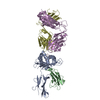 7jwjC 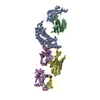 5swzS S: Starting model for refinement C: citing same article ( |
|---|---|
| Similar structure data |
- Links
Links
- Assembly
Assembly
| Deposited unit | 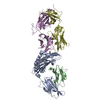
| ||||||||
|---|---|---|---|---|---|---|---|---|---|
| 1 |
| ||||||||
| Unit cell |
|
- Components
Components
-Protein , 4 types, 4 molecules ABDE
| #1: Protein | Mass: 40885.105 Da / Num. of mol.: 1 Source method: isolated from a genetically manipulated source Source: (gene. exp.)   |
|---|---|
| #2: Protein | Mass: 11879.356 Da / Num. of mol.: 1 Source method: isolated from a genetically manipulated source Source: (gene. exp.)  Homo sapiens (human) / Gene: B2M, CDABP0092, HDCMA22P / Production host: Homo sapiens (human) / Gene: B2M, CDABP0092, HDCMA22P / Production host:  |
| #4: Protein | Mass: 23117.295 Da / Num. of mol.: 1 Source method: isolated from a genetically manipulated source Source: (gene. exp.)   |
| #5: Protein | Mass: 27868.260 Da / Num. of mol.: 1 Source method: isolated from a genetically manipulated source Source: (gene. exp.)   |
-Protein/peptide , 1 types, 1 molecules C
| #3: Protein/peptide | Mass: 1026.099 Da / Num. of mol.: 1 / Fragment: NP-366 epitope (UNP residues 366-374) / Source method: obtained synthetically / Source: (synth.)   Influenza A virus / References: UniProt: Q9Q0U8 Influenza A virus / References: UniProt: Q9Q0U8 |
|---|
-Non-polymers , 2 types, 91 molecules 


| #6: Chemical | ChemComp-EDO / |
|---|---|
| #7: Water | ChemComp-HOH / |
-Details
| Has ligand of interest | N |
|---|---|
| Has protein modification | Y |
-Experimental details
-Experiment
| Experiment | Method:  X-RAY DIFFRACTION / Number of used crystals: 1 X-RAY DIFFRACTION / Number of used crystals: 1 |
|---|
- Sample preparation
Sample preparation
| Crystal | Density Matthews: 3.36 Å3/Da / Density % sol: 63.35 % |
|---|---|
| Crystal grow | Temperature: 298 K / Method: vapor diffusion, hanging drop / pH: 6.5 Details: 20% PEG3350, 0.2 M potassium/sodium tartrate, 0.1 M Bis-tris propane |
-Data collection
| Diffraction | Mean temperature: 100 K / Serial crystal experiment: N |
|---|---|
| Diffraction source | Source:  SYNCHROTRON / Site: SYNCHROTRON / Site:  Australian Synchrotron Australian Synchrotron  / Beamline: MX1 / Wavelength: 0.954 Å / Beamline: MX1 / Wavelength: 0.954 Å |
| Detector | Type: ADSC QUANTUM 210r / Detector: CCD / Date: Feb 27, 2018 |
| Radiation | Protocol: SINGLE WAVELENGTH / Monochromatic (M) / Laue (L): M / Scattering type: x-ray |
| Radiation wavelength | Wavelength: 0.954 Å / Relative weight: 1 |
| Reflection | Resolution: 3.02→44.27 Å / Num. obs: 28123 / % possible obs: 100 % / Redundancy: 2 % / CC1/2: 0.99 / Net I/σ(I): 11.53 |
| Reflection shell | Resolution: 3.02→3.13 Å / Mean I/σ(I) obs: 1.82 / Num. unique obs: 2781 / CC1/2: 0.8 |
- Processing
Processing
| Software |
| ||||||||||||||||||||
|---|---|---|---|---|---|---|---|---|---|---|---|---|---|---|---|---|---|---|---|---|---|
| Refinement | Method to determine structure:  MOLECULAR REPLACEMENT MOLECULAR REPLACEMENTStarting model: PDB entry 5SWZ Resolution: 3.02→44.27 Å / Cross valid method: THROUGHOUT
| ||||||||||||||||||||
| Displacement parameters | Biso mean: 63.18 Å2
| ||||||||||||||||||||
| Refine analyze | Luzzati coordinate error obs: 0.49 Å | ||||||||||||||||||||
| Refinement step | Cycle: 1 / Resolution: 3.02→44.27 Å
| ||||||||||||||||||||
| LS refinement shell | Resolution: 3.02→3.04 Å / Rfactor Rfree error: 0
|
 Movie
Movie Controller
Controller



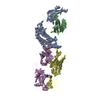
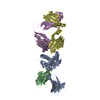
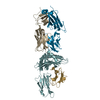
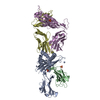
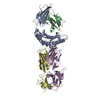
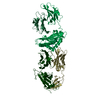

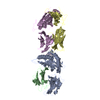

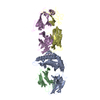
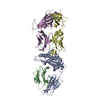
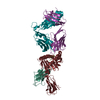
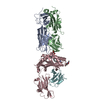
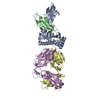
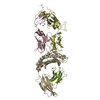
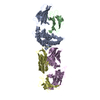
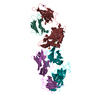
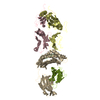
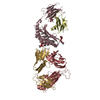
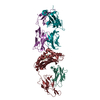
 PDBj
PDBj


